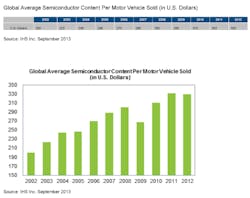The transformative role of infotainment technology is opening new business doors for makers and distributors of automotive electronics, according to new research detailing today’s demand for displays, apps, connectivity, and more in new cars and trucks.
Infotainment technology—which brings high-tech dashboard displays, Internet radio, and other connectivity solutions to automobiles—has “completely revolutionized cars and the automotive business as a whole,” according to the Automotive Technology Portals and Services group from electronics industry researcher IHS Inc. The company points to the dramatically different look of new-car dashboards today compared to just 10 years ago, for example.
“In 2002, an owner of a new Ford Focus gazed down upon a proprietary dashboard that had no connectivity and that was adorned only with an AM/FM/CD music player,” explains Ben Scott, technology solutions analyst for IHS Automotive. “In 2012, the proud owner of a new Focus beheld a dashboard rich with infotainment features, including multiple displays, a wealth of apps and services, and various means of connectivity. The major question that automakers need answered now is, ‘What will the Focus dashboard of 2022 look like?’”
Other key changes to the automotive market in the last 10 years include rising demand for semiconductors and the consumer’s demand for more bells and whistles. The average car in 2012 included roughly $330 worth of semiconductors, for example, up 65% from $200 in 2002 (see the figure). What’s more, infotainment systems now account for as much as 10% of the price of buying a new car. And in today’s increasingly connected world, many cars now allow drivers to connect with the outside world via telematics, cellular technology, Wi-Fi, or Bluetooth.
Looking ahead, IHS says innovations in safety, even more connectivity, and the expanded availability of telematics are on the horizon. Collision warning systems are a key safety example. Not only are such systems becoming more widely available, IHS also points to their evolution from alert-only systems to include some form of autonomous emergency braking.
Looking at connectivity, car makers are spending even more on research and development to enhance such systems, as cars represent the third-fastest growing connected device behind smart phones and tablets, IHS says.
Telematics will likely experience fast growth as well because it is being driven by both consumers and original equipment makers (OEMs), says IHS. Consumers want more capabilities such as Internet radio and emergency/concierge services while OEMs see the potential to collect vehicle data via telematics.
“It’s likely that in the developed regions, every car manufacturer will offer some type of connected service in its model lineup by 2015,” IHS says.
Such changes are welcome news to companies throughout the electronics supply chain, as the global automotive infotainment market reached $34.6 billion in 2012, according to a separate report from IHS released in late August. Panasonic of Japan remained the market’s top supplier for the second straight year, posting automotive infotainment revenue of nearly $4 billion, 12% of global market revenue (see the table). IHS lists the top five infotainment suppliers for 2012 as Panasonic, Pioneer (also of Japan), U.S.-based Harman International, Germany’s Continental, and Alpine/Alps Electric of Japan.










